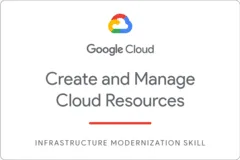
Create and Manage Cloud Resources 
Gain an introduction to Create and Manage Cloud Resources ▼
ADVERTISEMENT
Course Feature
![]() Cost:
Cost:
Free
![]() Provider:
Provider:
Qwiklabs
![]() Certificate:
Certificate:
Free Certification
![]() Language:
Language:
English
![]() Start Date:
Start Date:
On-Demand
Course Overview
❗The content presented here is sourced directly from Qwiklabs platform. For comprehensive course details, including enrollment information, simply click on the 'Go to class' link on our website.
Updated in [May 19th, 2023]
This course provides an overview of how to create and manage cloud resources using Google Cloud Platform. Participants will learn how to write gcloud commands and use Cloud Shell, create and deploy virtual machines in Compute Engine, run containerized applications on Google Kubernetes Engine, and configure network and HTTP load balancers.
At the end of the course, participants will be able to demonstrate their proficiency with Google Cloud products and services by completing the Create and Manage Cloud Resources quest and the final assessment challenge lab. Upon successful completion, participants will receive a skill badge that they can share with their network.
The course will begin with an introduction to Google Cloud Platform and its various components. Participants will learn how to write gcloud commands and use Cloud Shell to manage cloud resources. They will then learn how to create and deploy virtual machines in Compute Engine, run containerized applications on Google Kubernetes Engine, and configure network and HTTP load balancers.
Participants will also learn how to troubleshoot and debug cloud resources, as well as how to monitor and optimize their cloud resources. They will also learn how to use Google Cloud Platform’s security features to protect their cloud resources.
At the end of the course, participants will be able to demonstrate their proficiency with Google Cloud products and services by completing the Create and Manage Cloud Resources quest and the final assessment challenge lab. Upon successful completion, participants will receive a skill badge that they can share with their network.
[Applications]
Upon completion of the Create and Manage Cloud Resources course, participants will be able to apply their knowledge to create and deploy virtual machines in Compute Engine, run containerized applications on Google Kubernetes Engine, and configure network and HTTP load balancers. Additionally, participants will be able to demonstrate their proficiency with Google Cloud products and services by receiving a skill badge issued by Google Cloud.
[Career Paths]
1. Cloud Engineer: Cloud Engineers are responsible for designing, building, and managing cloud-based systems. They must be knowledgeable in cloud computing technologies, such as Google Cloud Platform, Amazon Web Services, and Microsoft Azure. They must also be able to develop and maintain cloud-based applications, as well as troubleshoot and resolve any issues that arise. As cloud computing continues to grow in popularity, the demand for Cloud Engineers is expected to increase.
2. Cloud Architect: Cloud Architects are responsible for designing and implementing cloud-based solutions. They must be knowledgeable in cloud computing technologies, such as Google Cloud Platform, Amazon Web Services, and Microsoft Azure. They must also be able to develop and maintain cloud-based applications, as well as troubleshoot and resolve any issues that arise. As cloud computing continues to grow in popularity, the demand for Cloud Architects is expected to increase.
3. DevOps Engineer: DevOps Engineers are responsible for automating and streamlining the development, testing, and deployment of applications. They must be knowledgeable in cloud computing technologies, such as Google Cloud Platform, Amazon Web Services, and Microsoft Azure. They must also be able to develop and maintain cloud-based applications, as well as troubleshoot and resolve any issues that arise. As cloud computing continues to grow in popularity, the demand for DevOps Engineers is expected to increase.
4. Cloud Security Engineer: Cloud Security Engineers are responsible for designing, implementing, and maintaining security measures for cloud-based systems. They must be knowledgeable in cloud computing technologies, such as Google Cloud Platform, Amazon Web Services, and Microsoft Azure. They must also be able to develop and maintain cloud-based applications, as well as troubleshoot and resolve any security issues that arise. As cloud computing continues to grow in popularity, the demand for Cloud Security Engineers is expected to increase.
[Education Paths]
1. Bachelor's Degree in Computer Science: A Bachelor's Degree in Computer Science is a great way to gain the skills and knowledge needed to create and manage cloud resources. This degree program typically covers topics such as programming, software engineering, computer networks, and database management. Additionally, students will learn about cloud computing, cloud architecture, and cloud security. With the increasing demand for cloud computing professionals, this degree path is becoming increasingly popular.
2. Master's Degree in Cloud Computing: A Master's Degree in Cloud Computing is a great way to gain the skills and knowledge needed to create and manage cloud resources. This degree program typically covers topics such as cloud architecture, cloud security, cloud storage, and cloud computing. Additionally, students will learn about cloud computing platforms, cloud computing services, and cloud computing applications. With the increasing demand for cloud computing professionals, this degree path is becoming increasingly popular.
3. Certificate in Cloud Computing: A Certificate in Cloud Computing is a great way to gain the skills and knowledge needed to create and manage cloud resources. This certificate program typically covers topics such as cloud architecture, cloud security, cloud storage, and cloud computing. Additionally, students will learn about cloud computing platforms, cloud computing services, and cloud computing applications. With the increasing demand for cloud computing professionals, this certificate path is becoming increasingly popular.
4. Professional Certificate in Cloud Computing: A Professional Certificate in Cloud Computing is a great way to gain the skills and knowledge needed to create and manage cloud resources. This certificate program typically covers topics such as cloud architecture, cloud security, cloud storage, and cloud computing. Additionally, students will learn about cloud computing platforms, cloud computing services, and cloud computing applications. With the increasing demand for cloud computing professionals, this professional certificate path is becoming increasingly popular.
Course Syllabus
A Tour of Google Cloud Hands-on Labs
In this first hands-on lab you will access the Google Cloud Platform Console and use these basic Google Cloud features: Projects, Resources, IAM Users, Roles, Permissions, and APIs.Creating a Virtual Machine
In this hands-on lab, youâll learn how to create a Google Compute Engine virtual machine and understand zones, regions, and machine types. To preview, watch the short video Create a Virtual Machine, GCP Essentials.Compute Engine: Qwik Start - Windows
Google Compute Engine lets you create and run virtual machines on Google infrastructure. In this lab you create a Windows Server instance in the Google Compute Engine and access it with RDP. Watch a short preview, Launch a Windows Server Instance, GCP Essentials.Getting Started with Cloud Shell and gcloud
In this hands-on lab you will learn how to connect to computing resources hosted on Google Cloud Platform via the web. You will also learn how to use Cloud Shell and the Cloud SDK gcloud command. For a preview, watch the short video Get Started with Cloud Shell, GCP Essentials.Kubernetes Engine: Qwik Start
Google Kubernetes Engine provides a managed environment for deploying, managing, and scaling your containerized applications using Google infrastructure. This hands-on lab shows you how deploy a containerized application with Kubernetes Engine. Watch the short video Manage Containerized Apps with Kubernetes Engine.Set Up Network and HTTP Load Balancers
In this hands-on lab, you'll learn how setup both network load balancers and HTTP load balancers for your application running in Compute Engine virtual machines.Create and Manage Cloud Resources: Challenge Lab
This challenge lab tests your skills and knowledge from the labs in the Create and Manage Cloud Resources quest. You should be familiar with the content of the labs before attempting this lab.Course Provider

Provider Qwiklabs's Stats at AZClass
Discussion and Reviews
0.0 (Based on 0 reviews)
Explore Similar Online Courses

Storying the Self: (Re)Claiming our Voices

How to Crochet

Python for Informatics: Exploring Information

Social Network Analysis

Introduction to Systematic Review and Meta-Analysis

The Analytics Edge

DCO042 - Python For Informatics

Causal Diagrams: Draw Your Assumptions Before Your Conclusions

Whole genome sequencing of bacterial genomes - tools and applications

Serverless Data Processing with Dataflow: Develop Pipelines

Serverless Data Processing with Dataflow: Foundations

IBM Cloud Essentials
 Related Categories
Related Categories
 Popular Providers
Popular Providers
Quiz
 Submitted Sucessfully
Submitted Sucessfully
1. What is a skill badge?
2. What is the Create and Manage Cloud Resources quest?
3. What is the final assessment challenge lab?


Start your review of Create and Manage Cloud Resources